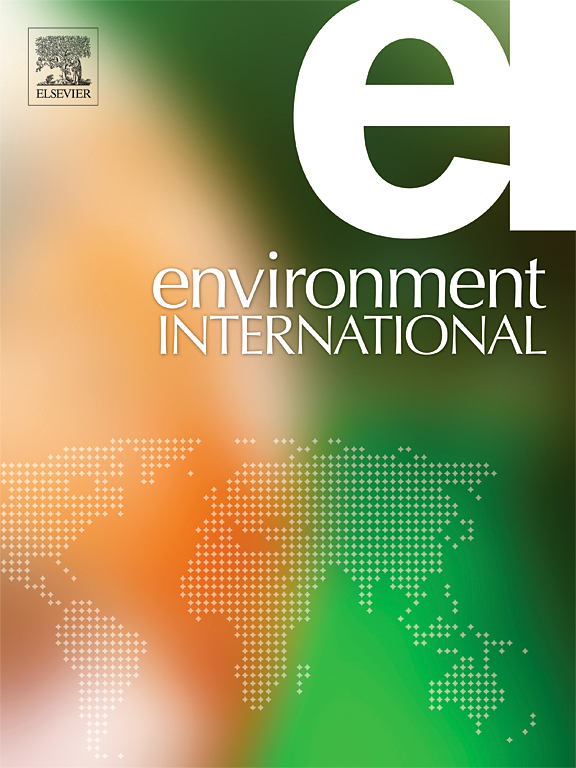Exploring the relationship between the androgen receptor and structural configuration of benzophenones: a combination of computational analysis and laboratory models
IF 9.7
1区 环境科学与生态学
Q1 ENVIRONMENTAL SCIENCES
引用次数: 0
Abstract
This study explored the interactions between benzophenones (BPs) and androgen receptors (AR) using computational and experimental approaches. BPs are potential endocrine disruptors that are commonly found in cosmetics, such as sunscreen. Molecular docking and molecular mechanics with generalized Born and surface area continuum solvation calculations revealed that dihydroxylation form of BP-1, BP-2 had higher binding affinities to AR compared with BP-1, BP-3. Key interactions with residues, such as Gln711 and Asn705, were identified. Density functional theory analysis revealed that BP-2 has a balanced energy gap, which contributes to its stability and reactivity. Cell-based assays validated these computational results, showing that BP-2 had stronger AR antagonistic effect than BP-1 and BP-3. Furthermore, BP-2 enhances the AR-mediated luciferase signal at specific concentration through inducing dimerization of cytosolic AR, whereas BP-1 and BP-3 had no AR agonistic effects. These changes in AR-mediated transcriptional activation activity were observed in flutamide and hydroxyflutamide as well. As expected, changes in AR-mediated endocrine disrupting potential due to configurational modification of BP-1 to BP-2 by dihydroxylation resulted in whole AR protein expression. These findings suggest that BP-2 is a strong AR modulator and a potential endocrine disruptor, offering insights into how similar compounds may interact with AR.


探索雄激素受体和二苯甲酮的结构构型之间的关系:计算分析和实验室模型的结合
本研究通过计算和实验方法探讨了二苯甲酮(bp)与雄激素受体(AR)之间的相互作用。bp是潜在的内分泌干扰物,通常存在于化妆品中,比如防晒霜。基于广义Born和表面积连续溶剂化计算的分子对接和分子力学结果表明,BP-1、BP-2的二羟基化形式与AR的结合亲和力高于BP-1、BP-3。鉴定了与Gln711和Asn705等残基的关键相互作用。密度泛函理论分析表明,BP-2具有平衡的能隙,这有利于其稳定性和反应性。基于细胞的实验验证了这些计算结果,表明BP-2比BP-1和BP-3具有更强的AR拮抗作用。此外,BP-2通过诱导胞质AR二聚化,在特定浓度下增强AR介导的荧光素酶信号,而BP-1和BP-3没有AR激动作用。在氟他胺和羟氟他胺中也观察到ar介导的转录激活活性的变化。正如预期的那样,由于BP-1被二羟基化修饰为BP-2, AR介导的内分泌干扰电位发生了变化,导致整个AR蛋白的表达。这些发现表明BP-2是一种强AR调节剂和潜在的内分泌干扰物,为类似化合物如何与AR相互作用提供了见解。
本文章由计算机程序翻译,如有差异,请以英文原文为准。
求助全文
约1分钟内获得全文
求助全文
来源期刊

Environment International
环境科学-环境科学
CiteScore
21.90
自引率
3.40%
发文量
734
审稿时长
2.8 months
期刊介绍:
Environmental Health publishes manuscripts focusing on critical aspects of environmental and occupational medicine, including studies in toxicology and epidemiology, to illuminate the human health implications of exposure to environmental hazards. The journal adopts an open-access model and practices open peer review.
It caters to scientists and practitioners across all environmental science domains, directly or indirectly impacting human health and well-being. With a commitment to enhancing the prevention of environmentally-related health risks, Environmental Health serves as a public health journal for the community and scientists engaged in matters of public health significance concerning the environment.
 求助内容:
求助内容: 应助结果提醒方式:
应助结果提醒方式:


